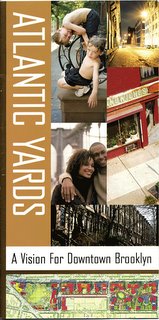 Welcome to the latest episode in Forest City Ratner’s parade of propaganda, a new brochure being distributed to Brooklynites titled “Atlantic Yards: A Vision for Downtown Brooklyn.” (Someone sent it to Develop Don’t Destroy Brooklyn, which posted it.)
Welcome to the latest episode in Forest City Ratner’s parade of propaganda, a new brochure being distributed to Brooklynites titled “Atlantic Yards: A Vision for Downtown Brooklyn.” (Someone sent it to Develop Don’t Destroy Brooklyn, which posted it.)Some key points:
--a new emphasis on the “historic, legally-binding Community Benefits Agreement,” which belies the illegitimacy of the CBA (See below for the Rev. Herbert Daughtry's evasions about the CBA and Community Board 8's Bill Batson's refutation of a claim in the brochure.)
--numerous photos of various happy Brooklynites, but no inkling of the traffic that would be caused by the largest development in Brooklyn’s history.
--photos of brownstones and other low-scale buildings, but no renderings of the 16 towers that would rise 30, 40, 50 and 60 stories. How can a high-rise project be promoted without tall buildings?
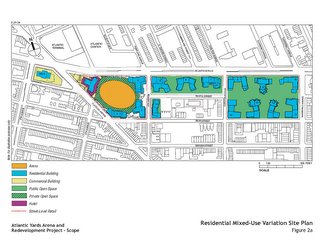 --an arena that looks like a… field (click on the brochure above right; by contrast, see the arena outline in the Empire State Development Corporation's Final Scope, right)
--an arena that looks like a… field (click on the brochure above right; by contrast, see the arena outline in the Empire State Development Corporation's Final Scope, right)--the repetition of some crucial deceptions and distortions, such as the claims that the project would bring $6 billion in tax revenue and be located in “Downtown Brooklyn.”
A history of mendacity
In mid-2004 came the flier from no known company (“Atlantic Yards”) that suggested that the New York Times itself—not the Gehry-besotted architecture critic—had endorsed the project.
Then came the flier that asserted that the project would be “built over the 19th Century train yard” (which is only 8.3 acres of a now 22-acre project) and pledged that 50 percent of all the housing—not merely the rental units, as now promised—would be affordable.
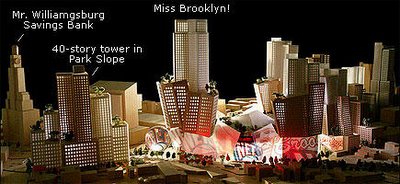 Last June emerged the Brooklyn Standard, which pretended to be a newspaper, with “Letters to the Editor” from the likes of Mayor Bloomberg; even the New York Times dismissed it in a headline "O.K., the Whole Paper Is Basically an Ad." Then came a follow-up issue of the Brooklyn Standard, featuring fake bylines, and conclusory declarations that the project wouldn’t "bring in more traffic than the area can handle.”
Last June emerged the Brooklyn Standard, which pretended to be a newspaper, with “Letters to the Editor” from the likes of Mayor Bloomberg; even the New York Times dismissed it in a headline "O.K., the Whole Paper Is Basically an Ad." Then came a follow-up issue of the Brooklyn Standard, featuring fake bylines, and conclusory declarations that the project wouldn’t "bring in more traffic than the area can handle.”Last month we saw the new AtlanticYards.com web site, with distortions and lies in text and in photos.
Downtown Brooklyn?
 There's no inkling of Frank Gehry's design (as revealed in the 7/5/05 New York Times, above right, with addenda by NoLandGrab.) Rather, the front of the brochure proclaims Forest City Ratner’s mantra, “A Vision for Downtown Brooklyn.” Except the project won’t be downtown, which the New York Times has belatedly acknowledged, and the photos—of low-rise Brooklyn, including brownstones—don’t provide any sense of the enormous scale of the project. The vision in this flier is so new it's not anywhere near Downtown Brooklyn.
There's no inkling of Frank Gehry's design (as revealed in the 7/5/05 New York Times, above right, with addenda by NoLandGrab.) Rather, the front of the brochure proclaims Forest City Ratner’s mantra, “A Vision for Downtown Brooklyn.” Except the project won’t be downtown, which the New York Times has belatedly acknowledged, and the photos—of low-rise Brooklyn, including brownstones—don’t provide any sense of the enormous scale of the project. The vision in this flier is so new it's not anywhere near Downtown Brooklyn.Marty’s seal of approval
 The next page contains a note from Marty Markowitz, our elected Borough President. He doesn’t work for Forest City Ratner; he works for the public. But he repeats their propaganda about the site location: Atlantic Yards, a development planned for the rundown railyards at the intersection of Atlantic and Flatbush Avenues…
The next page contains a note from Marty Markowitz, our elected Borough President. He doesn’t work for Forest City Ratner; he works for the public. But he repeats their propaganda about the site location: Atlantic Yards, a development planned for the rundown railyards at the intersection of Atlantic and Flatbush Avenues…Even though there’s been no planning for this site, Marty asserts: It’s crucial that we plan with a grand vision for the future.
Fun with photos
 The third page of the flier shows a distorted photo of the railyards, implying that the 8.3 acres of railyards constitute the majority of the 22-acre site. Because the fisheye photo is shot from Atlantic Avenue, we don’t see the row-house scale of Dean Street that would be obliterated by the project.
The third page of the flier shows a distorted photo of the railyards, implying that the 8.3 acres of railyards constitute the majority of the 22-acre site. Because the fisheye photo is shot from Atlantic Avenue, we don’t see the row-house scale of Dean Street that would be obliterated by the project.The flier, unlike FCR’s web site, makes repeated reference to the term “Brooklyn Nets,” as if invoking local pride. But, as noted, it’s quite possible that the team would not keep the name “Nets.”
The page also quotes a Daily News editorial that declared the project “a slam dunk for Brooklyn.” The Daily News editorials have often skirted the facts; at least this time Forest City Ratner is quoting an editorial written within the past year rather than, as in the new web site, one published in January 2004.
Seal of approval
 The fourth page of the brochure features only a photo--an ebullient Caucasian mom and her kid, plus that community benefits logo. That’s a curious bit of racial politics. The eight groups that signed the CBA mostly came from Central Brooklyn and represented black constituencies. (The New York State Association of Minority Contractors and ACORN represent a larger constituency of minorities.) Check the CBA signing ceremony photos at the BUILD web site.
The fourth page of the brochure features only a photo--an ebullient Caucasian mom and her kid, plus that community benefits logo. That’s a curious bit of racial politics. The eight groups that signed the CBA mostly came from Central Brooklyn and represented black constituencies. (The New York State Association of Minority Contractors and ACORN represent a larger constituency of minorities.) Check the CBA signing ceremony photos at the BUILD web site.The next page contains information on the housing, emphasizing that 50 percent of the rental units—not the project itself, as originally stated--would be reserved for middle- and low-income families. There’s an endorsement from State Senator Martin Malave-Dilan and a reminder that recipients can fill out a postcard to be notified when housing applications are available.
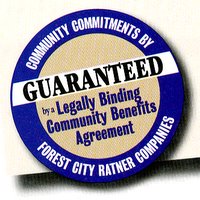 There’s no mention, of course, that the project remains in the early stages of an environmental review; a Draft Environmental Impact Statement is due within weeks from the Empire State Development Corporation. After that, there will be a comment period and at least one public hearing. Yet Marty Markowitz declares: This booklet is another step in familiarizing Brooklynites with the details of the project.
There’s no mention, of course, that the project remains in the early stages of an environmental review; a Draft Environmental Impact Statement is due within weeks from the Empire State Development Corporation. After that, there will be a comment period and at least one public hearing. Yet Marty Markowitz declares: This booklet is another step in familiarizing Brooklynites with the details of the project.There’s a photo that suggests some form of racial harmony: a white guy on the phone, looking up in the sky, while a black woman next to him looks toward him. They could be, what, colleagues? Like most of the photos in the flier, the shot focuses tightly on people; there’s a black iron railing in the background and a glimpse of a high-rise building in the background. Downtown Brooklyn?
Dubious figures
The sixth page repeats the $6 billion lie, claiming that the project would bring $6 billion in tax revenues to the city and state—a spurious number produced by an economist the developer hired.
The developer now promises that Atlantic Yards will provide 3800 permanent jobs and 15,000 union construction jobs. Note that the developer no longer uses the term "created"; perhaps that’s an acknowledgement that a majority of the projected 2500 office jobs would be moved from Manhattan, rather than new, and that many of the 400 arena jobs might be filled by current employees from New Jersey.
In an accompanying photo, a gelled-hair young fellow (South Asian? Hispanic?) is posed with the words “Brooklyn Works” in the background. The setting is the Brooklyn waterfront, not anything near the Atlantic Yards site.
Who's investing?
On the seventh page, we get a quote from Kathryn Wilde, President of the Partnership for New York City, a business group, who declares that, because of the jobs, retail space, and office space, “Atlantic Yards represents a long-term economic investment in the future of Brooklyn.” On the previous page, Atlantic Yards is declared to be a $3.5 billion investment.”
Absent from those formulations is an actor. Who’s doing the investing? How much will Forest City Ratner put up, and how much will be funded through bonds repaid via future revenues or some other financing scheme?
 Page 8 is another all-photo, no text page except for that Community Benefits Agreement seal of approval. It's a happy couple (right) at Celebrate Brooklyn at the bandshell in Prospect Park, some two dozen blocks from the site
Page 8 is another all-photo, no text page except for that Community Benefits Agreement seal of approval. It's a happy couple (right) at Celebrate Brooklyn at the bandshell in Prospect Park, some two dozen blocks from the siteThe ninth page, concerning open space and recreation, reminds us that the arena would be open to community events and “family events” such as concerts and circuses. Unmentioned is exactly how much use would be for nonprofit events and for-profit events. We’re told that the project will include seven acres of open space; unmentioned is that the open space is achieved in part by taking a city street, and that the amount of open space would be far less than recommended by city guidelines.
Community benefits?
On the tenth page, the deceptions increase. The brochure states:
Eight community-based organizations worked with Forest City Ratner to produce a historic, legally-binding “Community Benefits Agreement” (CBA) for Atlantic Yards to guarantee the jobs, housing, and community amenities that are part of the plan.
That’s bunk. First, as noted, experts on CBAs say this one’s not legitimate because it involved groups that supported the project from the start. The New York Observer reported that only two of the eight were incorporated at the time the document was signed.
Questioning Rev. Daughtry
 And what’s a community-based organization anyhow? I got a chance to question the Rev. Herbert Daughtry, whose Downtown Brooklyn Neighborhood Alliance is one of the signatories, after a forum last Thursday. (He's in the center of the photo, from AtlanticYards.com, between Mayor Bloomberg and Bruce Ratner.)
And what’s a community-based organization anyhow? I got a chance to question the Rev. Herbert Daughtry, whose Downtown Brooklyn Neighborhood Alliance is one of the signatories, after a forum last Thursday. (He's in the center of the photo, from AtlanticYards.com, between Mayor Bloomberg and Bruce Ratner.)I said I’d read the CBA and still wondered what the term “community” meant. The minority community? The black community? Brooklyn at large? He replied, “The community is Brooklyn and beyond.”
Can the eight signatories represent the community? Daughtry was nonplussed. “Two groups can represent their interests,” he said.
How big is his group? “Those who know don’t say,” he responded cryptically. “Those who say don’t know.”
Finally, I asked: What percentage of the group’s funding comes from Forest City Ratner? Daughtry turned away without responding. But his group has gotten at least $50,000 from the developer.
Greg LeRoy, executive director of Good Jobs First, told the Brooklyn Papers last year that signatories shouldn’t be accepting favors from developers, such as the free rent that signatory BUILD gets from Forest City Ratner: “Anytime you have negotiations in which there are competing self-interests, and one side grants a favor to the other, that’s a red flag.”
Role of the CBs?
The brochure states:
Three local community boards (CBs 2, 6, 8) and other elected officials also served as advisors in crafting the CBA.
I asked Bill Batson, chair of CB8’s Atlantic Yards EIS Subcommittee and current candidate for State Assembly, if that was accurate. He said:
“From my intimate knowledge, in the process, that claim is false. I know that no member of the community board saw the CBA before it was announced publicly. There was an effort to circulate an early draft. It was poorly Xeroxed, blank paper without letterhead. It had just been sent over without any explanation. We got no one to answer questions, and a document that was, quite frankly, insulting."
CBA ratified?
The brochure states:
The CBA has been ratified by more than 200 community leaders and organizations.
The term “ratified” is a step up from “affirmed,” which was what was used last year. As the New York Observer pointed out: The Real Estate asked for the list and counted fewer than 175; and that's only if "organizations" include elected officials, restaurants and real-estate agencies, as well as block associations and the like. But we were nonetheless surprised it had traveled so far, so fast. Why, there are groups from as far away as Queens and Manhattan on this list!
Market survey?
 Finally, after an enthusiastic quote from ACORN’s Bertha Lewis (who’s contractually obligated to support the project), we get a questionnaire. Forest City Ratner wants to know what aspects of Atlantic Yards we’re interested in: shopping, jobs, hoops, open space, etc.
Finally, after an enthusiastic quote from ACORN’s Bertha Lewis (who’s contractually obligated to support the project), we get a questionnaire. Forest City Ratner wants to know what aspects of Atlantic Yards we’re interested in: shopping, jobs, hoops, open space, etc.And then, “Which aspects of the project’s historic, legally binding Community Benefits Agreement is most important to you?” Have the modifiers historic, legally binding been so focus-grouped that they will be appended to every future utterance regarding the CBA? Will there be an asterisk indicating that Forest City Ratner can get out of some obligations, for example, by paying $500,000?
Note for example that the relocation agreement isn’t quite as generous to renters as FCR promises; some might leave their current dwellings and see the rent differential evaporate after three years.
What’s missing
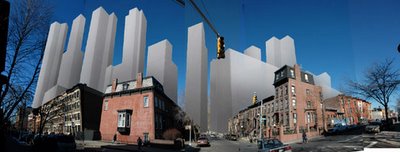 But what’s most striking about this document is not what it contains but what it ignores: Forest City Ratner’s nearby projects such as the Atlantic Center mall; the congested intersection of Atlantic and Flatbush avenues; and the enormous development planned. Does Forest City Ratner—and allies such as Marty Markowitz and Mayor Bloomberg—really think Brooklynites are that stupid?
But what’s most striking about this document is not what it contains but what it ignores: Forest City Ratner’s nearby projects such as the Atlantic Center mall; the congested intersection of Atlantic and Flatbush avenues; and the enormous development planned. Does Forest City Ratner—and allies such as Marty Markowitz and Mayor Bloomberg—really think Brooklynites are that stupid?(Projection of building scale from OnNYTurf.)
Comments
Post a Comment